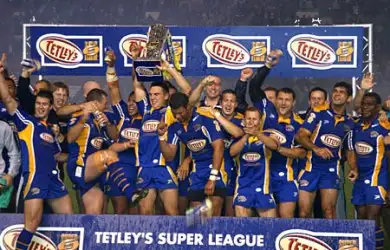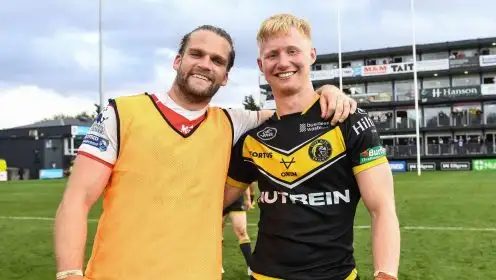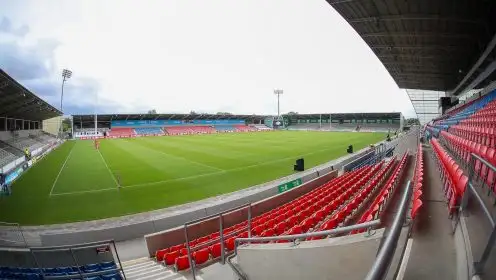BLOG: Has rugby league moved forward since 2004?

Rugby league is once again awash with debate as to what to do with the game’s structure moving forward.
Cries for top of the league to be crowned champions, further tweaks or the possible abolition of the controversial Super 8s system and even increasing (or decreasing) the number of teams in Super League are being debated on social media.
The sport has got itself into a dangerous cycle of constant changes and it got me thinking – has the game moved forward at all since 2004?
Why 2004 you might ask. This was the last fairly stable year before changes started happening.
Super League had 12 teams. Top six play-offs. Bottom team relegated.
National League 1 had 10 teams. Top six play-offs. One team promoted via play-offs. Bottom team relegated. Second bottom team in relegation play-off.
National League 2 had 10 teams. Top team promoted. Rest of top six in play-offs with second bottom team from NL1. Two teams promoted.
There was even a National League 3, won by current League 1 side Coventry Bears, which had 14 teams.
Leeds won the Grand Final for the first time (against Bradford in front of 65,547 at Old Trafford), Castleford went down on the final day of the season following that infamous match against Wakefield, Leigh earned their first promotion to Super League with a dramatic extra time victory over Whitehaven in the Grand Final, Halifax survived relegation to NL2 via the play-offs, while Barrow went up to NL1 in place of Keighley.
The Challenge Cup final saw 73,734 watch St Helens beat Wigan and we still had the glorious Northern Rail Cup, this year won by Leigh over Hull KR.
Internationally, Great Britain beat Australia for the first time in a tournament in 31 years (24-12 at Wigan), but lost the Tri-Nations final to the Kangaroos.
There were two live Super League games on Sky Sports each week (Friday and Saturday), with a National League 1 game live on the Thursday night.
Super League average crowd: 8,833
National League 1 average crowd: 1,482
National League 2 average crowd: 726
So where has it all gone wrong since then?
In 2005, an extra relegation place was added to Super League to accommodate the inclusion of Catalan Dragons. Widnes became the first team to be relegated from 11th place.
They were joined in 2006 by Castleford, who were also relegated from 11th place due to Catalan finishing bottom and being exempt from relegation for three years.
While Catalan have added colour to Super League, the French league has not moved forward, the development of French players doesn’t seem to have and England are now having to fly halfway across the world to play Samoa in a mid-season test because even with 10 years of Super League, France can’t generate reasonable opposition.
Castleford and Widnes played the last National League 1 Grand Final with promotion riding on it in 2007, Castleford coming out on top in front of a sell-out 20,814 crowd at Headingley, a National League record – and three times bigger crowd than the acclaimed Million Pound Game between Hull KR and Salford last season (6,562).
Great Britain went on to beat Australia in Sydney in 2006 (the first time since 1988), but GB was then scrapped the following year following the whitewash test series win over New Zealand.
In 2008, promotion and relegation to Super League was scrapped in favour of a licensing system. The league was increased to 14 teams. Salford and Celtic Crusaders were awarded licenses for 2009-2011.
That meant a glass ceiling for the Championship for the next six years, something which Featherstone Rovers suffered much from. Despite this, Featherstone are the only one of the three clubs in their area to have made significant ground improvements since 2004, which was one of the cornerstones of the whole licensing process.
The Super League play-offs was increased to the top eight teams, and Leeds were able to win the title twice from fifth place.
French team Toulouse joined the Championship for 2009-2011, with the view to achieving the on-field criteria to enable them to apply for a Super League licence in 2012. They failed, miserably.
As a result of Toulouse’s inclusion, the National Leagues 1 and 2 were rebranded to Championship and Championship One (later amended to League One).
In 2011, the next round of Super League licences were up for grabs. Widnes, despite not winning the league or appearing in a Grand Final, earned a licence for 2012 having met the on-field criteria by winning the 2009 Northern Rail Cup. In dramatic fashion, Crusaders exited Super League having pulled out at the 11th hour on the day the licenses were announced, giving a reprieve to Wakefield.
Also in 2011, the amateur game was switched from winter to summer, to align it with the professional game. This has seen participation numbers decline and you don’t have to look far for stories of community teams folding as a result.
Come 2014, Super League was reduced back down to 12 teams – London and Bradford making way having finished in the bottom two – and the current Super 8s concept was introduced (I won’t bother explaining how this works, as that’s another article in itself).
A consequence of the Super 8s was live Championship rugby league disappeared from our screens entirely (with the exception of the new Summer Bash), a huge backward step and a massive reduction in exposure for the second tier.
The third tier, now called League 1, has a mix of expansion and traditional clubs – many of whom are now crippled by the extraordinary travel costs associated with such a league. It is crying out for some sort of North/South split to save the clubs.
Another issue with the Super 8s is that a quarter of the season is completely unknown until the end of July – meaning it’s impossible to plan whether you can get to seven of your club’s games. This is turning people away from buying season tickets, as they can’t be sure whether they aren’t going to miss any games. Rugby league has always been a season ticket sport.
The live Saturday game was replaced by televised Sky games on Thursdays and Mondays, though Mondays have since disappeared once again.
Sky claim there is more rugby league broadcast than before, assisted by the fact they broadcast all Catalans home games. But their highlights and magazine shows of previous years have long since disappeared.
In 2016, based on regular season (first 23 rounds) attendances have stagnated despite all the glitz and glamour around changes that were supposedly meant to make things more exciting, compelling, innovative etc.
The average Super League attendance has, in 13 years, increased by just 301 (up to 9,134).
Fast forward to today in 2017. Here we are. All that wasted energy and change in the past 13 years – has it really taken the game forward?
What we should have been doing is taking 2004 forward and increasing participation (especially outside the heartlands), improving marketing, and crucially, commercial opportunities. Can anyone honestly say that’s been done since?



